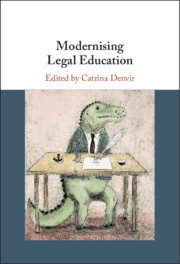Book contents
- Modernising Legal Education
- Modernising Legal Education
- Copyright page
- Contents
- Figures
- Tables
- About the Contributors
- Foreword
- Introduction
- 1 Do Lawyers Need to Learn to Code?
- 2 Experiential Legal Education
- 3 Skills Swap?
- 4 Scaling the Gap
- 5 Bringing ODR to the Legal Education Mainstream
- 6 Design Comes to the Law School
- 7 Developing ‘NextGen’ Lawyers through Project-Based Learning
- 8 Same As It Ever Was?
- 9 Ludic Legal Education from Cicero to Phoenix Wright
- 10 The Gamification of Written Problem Questions in Law
- 11 Virtually Teaching Ethics
- 12 Paths to Practice
- 13 ‘Complicitous and Contestatory’
- Afterword
- References
13 - ‘Complicitous and Contestatory’
A Critical Genre Theory Approach to Reviewing Legal Education in the Global, Digital Age
Published online by Cambridge University Press: 30 December 2019
- Modernising Legal Education
- Modernising Legal Education
- Copyright page
- Contents
- Figures
- Tables
- About the Contributors
- Foreword
- Introduction
- 1 Do Lawyers Need to Learn to Code?
- 2 Experiential Legal Education
- 3 Skills Swap?
- 4 Scaling the Gap
- 5 Bringing ODR to the Legal Education Mainstream
- 6 Design Comes to the Law School
- 7 Developing ‘NextGen’ Lawyers through Project-Based Learning
- 8 Same As It Ever Was?
- 9 Ludic Legal Education from Cicero to Phoenix Wright
- 10 The Gamification of Written Problem Questions in Law
- 11 Virtually Teaching Ethics
- 12 Paths to Practice
- 13 ‘Complicitous and Contestatory’
- Afterword
- References
Summary
In this chapter we describe a discourse framework for understanding the historical development of modern reports into legal education in England and Wales by analysing the textual features of genre markers. We then apply this framework to a specific subset of topoi within such reports, namely the coverage given to digital technologies within legal education. We make three related claims. First, the discourse and rhetorics of reports on legal education has scarcely been analysed in the research literature, and we begin that process here. Second, the culture and context within which digital innovation is reported, analysed and recommended upon in regulatory reports is relatively shallow and ‘theory-lite’. We need to draw sophisticated insights into our understanding of digital in a variety of disciplines and discourses (e.g. media, education and discourse analysis generally), and apply those to legal education. Third, the genre-form of reports on innovation inhibit or constrain our ability to develop imaginative, theory-rich and persuasive accounts of digital cultures for legal education. Our case study has implications not just for law schools, but also and more significantly, for regulators and accreditors.
Keywords
- Type
- Chapter
- Information
- Modernising Legal Education , pp. 239 - 257Publisher: Cambridge University PressPrint publication year: 2020



